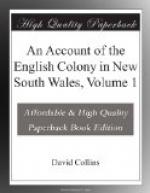Early in the month an alteration took place in the weekly ration, the four pounds of wheat served to the convicts were discontinued, and a substitution of one pint of rice, and two pints of gram (an East India grain resembling dholl) took place. The serving of wheat was discontinued for the purpose of issuing it as flour; to accomplish which a mill had been constructed by a convict of the name of James Wilkinson, who came to this country in the Neptune. His abilities as a millwright had hitherto lain dormant, and perhaps would longer have continued so, had they not been called forth by a desire of placing himself in competition with Thorpe the millwright sent out by government.
His machine was a walking mill, the principal wheel of which was fifteen feet in diameter, and was worked by two men; while this wheel was performing one revolution, the mill-stones performed twenty. As it was in opposition to the public millwright that he undertook to construct this mill, he of course derived no assistance whatever from Thorpe’s knowledge of the business, and had to contend not only with his opinion, but the opinion of such as he could prejudice against him. The heavy part of the work, cutting and bringing in the timber, and afterwards preparing it, was performed by his fellow-prisoners, who gave him their labour voluntarily. He was three months and five days from taking it in hand to his offering it for the first trial. On this trial it was found defective in some of the machinery, which was all constructed of the timber of the country, and not properly seasoned. Its effects in grinding were various; at first it would grind no more than two bushels an hour; with some alteration, it ground more, and did for some time complete four bushels; it afterwards ground less, and at the end of the month produced not more than one bushel. Had the whole of the machinery been upon a larger scale, there was reason to suppose it would have answered every expectation of the most interested. The constructor, however, had a great deal of merit, and perceiving himself what the defects were in this, he undertook to make another upon a larger scale at Sydney, and on an improved plan. For this purpose, all the artificers and a gang of convicts were brought down from Parramatta, and were first employed in forming a timber-yard at Petersham, two hundred feet square.
At that place, a small district in the neighbourhood of Sydney so named by the lieutenant-governor, nine huts for labouring convicts were built, and sixty acres of government ground cleared of timber, twenty of which were sown with Indian corn. This was the only addition made to the public ground this season; and the sole difference that was observable in the progress of our cultivation consisted in sowing this year with wheat a large portion of that ground which last year grew Indian corn. The weather throughout the month continued extremely favourable for wheat.




